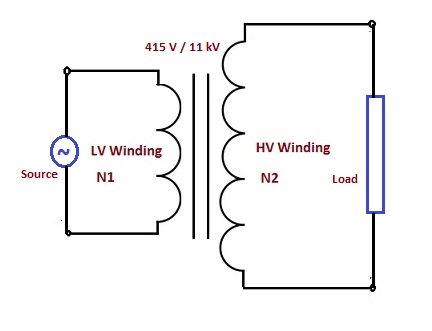Difference between Step-up and Step-down Transformer
In fact, these two terms, i.e. step-up or step-down has significance from operational point of view. From construction and design point of view, there is no difference between step-up and step-down transformer.
A given transformer can be used as step-up or step-down transformer. If the HV (High Voltage) winding is connected to supply main and LV (low voltage) winding to load, the transformer works as Step-down transformer. This is because, the transformer is delivering the power at a decreased voltage at secondary terminal. Figure below shows a step-down transformer.
The above transformer, works as a step-up transformer. Here the LV winding is primary winding and HV winding is secondary winding.
Thus a transformer can only be termed as Step up or Step down when it is in service. One can distinguish a transformer as step-up or step-down only after having knowledge of their application.
A stand alone or isolated transformer cannot be said step-up or step-down transformer. Thus there is no any difference between step-up and step-down transformer from core construction, winding design and working principals point of view. But from operational aspect, yes there exists some difference between the two.
The major differences between Step-up and Step-down Transformer lies in their application.
Difference between Step-up and Step-down Transformer:
| Sr. No. | Step-up Transformer | Step-down Transformer |
| 1) | The output voltage of Step-up transformer is more than the source voltage. | The output voltage of Step-down transformer is less than the source voltage. |
| 2) | LV winding of transformer is the primary and HV winding is secondary. | HV winding of transformer is the primary and LV winding is secondary. |
| 3) | The secondary voltage of Step-up Transformer is greater than its primary voltage. | The secondary voltage of Step-down Transformer is less than its primary voltage. |
| 4) | The number of turns in primary winding is less than the secondary winding. | The number of turns in primary winding is more than the secondary winding. |
| 5) | Primary current of transformer is more than the secondary current. | Secondary current is more than the primary current. |
| 6) | Step-up transformer is generally used for power transmission. Generator Transformer in power plant is one example of Step-up Transformer. | Step-down Transformer is used in power distribution. Transformer in residential colony is one example of step-down transformer. |


Comments
Post a Comment
Do not enter any spam link in the comment box.